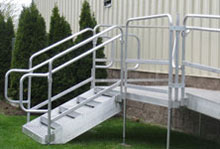
Access Ramps Resources
- Home
- Types of Access Ramps
- Access Ramps for Vehicles
- Access Ramps for Wheelbarrows
- Access Ramps for Wheelchairs
- Bariatric Access Ramps
- Folding Access Ramps
- Modular Access Ramps
- Multi-Fold Access Ramps
- Permanent Access Ramps
- Roll up Access Ramps
- Single-Fold Access Ramps
- Solid Access Ramps
- Suitcase Access Ramps
- Telescoping Access Ramps
- Temporary Access Ramps
- Threshold Access Ramps
- Track Access Ramps
Types of Access Ramps
Generally speaking, access ramps are typically thought of as contraptions that ease transportation those who are less mobile to get from one place to another. More often than not, access ramps enables one to either transport oneself and/or people or goods from a higher placed location to a lower location or vice versa. A more general definition would be a contrivance that assists those who have either physical limitations or limitations that are caused by external factors to overcome barriers. As such, since there are various reasons that may bring about the use of access ramps, there are thus many types of access ramps to serve these needs. Not only are there different types of access ramps to address different needs, different types of access ramps are also required for different functions depending on where they are used as even if access ramps basically perform more or less the same thing.
The design of access ramps, regardless of its specific functions or individual needs are by and large inclinatory, with varying degrees of steepness. Since there are different types of access ramps, these access ramps can either be of a permanent or semi-permanent or even portable. Permanent access ramps usually serve a long-term need and are thus made of either steel or wood, are commonly bolted or cemented into place. Short-term needs usually call for the utilization of semi-permanent access ramps.
Compared to permanent access ramps, semi-permanent access ramps customarily rest atop a cement pad or on top of the ground but are also made out of the same materials as permanent access ramps i.e. steel or wood. These two materials provide a certain degree of stability although access ramps that are made out of steel are more durable than access ramps that are made out of wood as they are heavier, thereby able to bear more weight.
However, steel access ramps are also considerably more expensive than wooden access ramps. On the other hand, portable access ramps are mostly made out of lightweight materials such as aluminum or steel alloys that enable ease of use and easy transportation as portable access ramps typically need to be folded. Even though portable access ramps are predominantly intended for either home or building use, they are also used with vehicles to load (or unload) a vacant piece of mobility equipment or to load (or unload) an occupied mobility device when both the passenger and the device are easy to manage. Portable access ramps also offer a more cost-effective solution than their permanent and semi-permanent counterparts.
Although there are indeed many different types of access ramps, each of these access ramps must be carefully designed in order to fully maximize their usefulness. These simple contrivances actually do make a difference in people’s lives, not only by simplifying needs but also making the impossible, possible. In addition to this, access ramps also enable a society to play a more fulfilling role in life. In some places, access ramps are actually a legal requirement thereby setting a standard for quality living.
